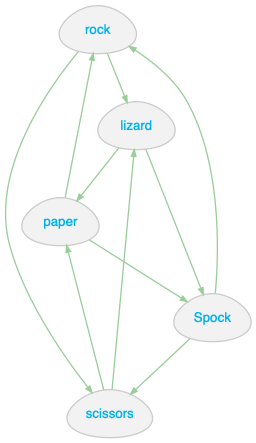Python library for creating and drawing graphs and taking advantage of graph properties
Project description
Abstract
Abstract is a Python library for creating and drawing graphs and taking advantage of graph properties.
Installation
pip install abstract
or
pip install git+https://github.com/idin/abstract.git
Graph
Introduction
In computer science, a graph is an abstract data type that is meant to implement the undirected graph and directed graph concepts from mathematics; specifically, the field of graph theory. [1]
A graph data structure consists of a finite (and possibly mutable) set of vertices or nodes or points, together with a set of unordered pairs of these vertices for an undirected graph or a set of ordered pairs for a directed graph. These pairs are known as edges, arcs, or lines for an undirected graph and as arrows, directed edges, directed arcs, or directed lines for a directed graph. The vertices may be part of the graph structure, or may be external entities represented by integer indices or references. [1]
Usage
The Graph class allows you to create nodes and edges and visualize the resulting graph. Edges can have direction which indicates parent-child relationship.
To construct a new graph, use Graph().
from abstract import Graph
graph = Graph()
add_node
The add_node method creates a node in the graph and returns a Node object.
It takes the following arguments:
- name: name of the new node (should be unique); snake case is recommended
- label (optional): it can be any string, if it is missing the name will be displayed
- value (optional): can be any object
- style (optional): it should be a NodeStyle object and is only used for rendering
- if_node_exists: what to do if a node with this name exists and can be 'warn', 'error', or 'ignore'; default is 'warn'
node_order = [
'scissors', 'paper', 'rock', 'lizard', 'Spock', 'scissors',
'lizard', 'paper', 'Spock', 'rock', 'scissors'
]
# add nodes (avoid duplicates)
for node in set(node_order):
node = graph.add_node(name=node)
connect (add an edge)
The connect method creates an edge from a start node to an end node. The start and end arguments can be either names of nodes or the Node objects.
for index in range(len(node_order)-1):
edge = graph.connect(start=node_order[index], end=node_order[index+1])
get_node
To retrieve a node from the graph you can use the get_node method which returns a Node object.
rock = graph.get_node('rock')
draw (render)
The render method visualizes the graph and if a path is provided it saves it to an image file that can be a pdf or png. The file format is infered from the path argument. The draw method is just an alias for render.
# just visualize the graph
graph.draw()
# save as a png file and view the file
graph.draw(path='my_graph.png', view=True)
Graph(obj)
You can create a graph from any object that has a "__graph__()" method. Examples of such objects are:
- Graph class from this library
- Pensieve class from the pensieve library
from pensieve import Pensieve
from abstract import Graph
pensieve = Pensieve()
pensieve['one'] = 1
pensieve['two'] = 2
pensieve.store(key='three', precursors=['one', 'two'], function=lambda x: x['one'] + x['two'])
graph = Graph(pensieve)
draw_graph
In case you just want to draw the graph of an object or create a graph and immediately render it you can just use the draw_graph method. It accepts anything that the Graph class accepts.
from pensieve import Pensieve
from abstract import draw_graph
pensieve = Pensieve()
pensieve['one'] = 1
pensieve['two'] = 2
pensieve.store(key='three', precursors=['one', 'two'], function=lambda x: x['one'] + x['two'])
draw_graph(pensieve)
Future Features
- Create a graph from:
- list of dictionaries
- dataframe
- Create a new graph by filtering a graph
Project details
Release history Release notifications | RSS feed
Download files
Download the file for your platform. If you're not sure which to choose, learn more about installing packages.
Source Distribution
Built Distribution
Hashes for abstract-2019.12.30.1-py3-none-any.whl
| Algorithm | Hash digest | |
|---|---|---|
| SHA256 | 16cd1fad5524c79140be343144addd43a6aae38b5737fc252a7590fad317d980 |
|
| MD5 | 17be8993edafb3a7897fc404096d9b41 |
|
| BLAKE2b-256 | 32c39dcff0cc9f58a375132adece439feb7039aafd48a4d46013700ce5038e9b |












